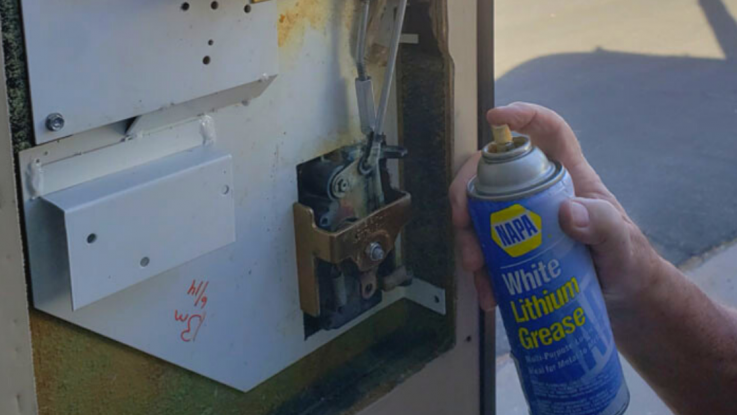
Three summers ago, we accidentally became locked out of our motorhome, while the engine was running. How it happened was bizarre. We had pulled into a casino in Oklahoma for a couple of nights. We both got out and walked over to the security guard to ask his advice on long-term parking and general rules. After we were directed to the long-term parking, we walked back to our coach. Yikes! I couldn’t open the door. It had locked. That was startling. It was odd that we had mentioned just days earlier that the door was getting harder to open and we should look at the mechanism.
Thank goodness we left a window unlocked, sage advice we had received from full-timer friends. Now it was time to borrow a ladder so I could climb into our coach and open the door from within. It may have only been a brief time, but it was another lesson learned. At least I was able to open the door and we proceeded to our parking spot without incident. As you might guess, the next day we did a deep dive into the locking mechanism. We were glad we didn’t have to call a locksmith.
Motorhomes and RVs in general have solid, heavy doors. Besides temperature fluctuation, vibration takes a toll on hinges and moving metal parts. Our coach’s front door deadbolt lock began sticking, and soon it became harder to open the door. It was time to give it and the slide lock needed lubrication, just like we do to the keyholes for keys that stick now and again, weather dependent.

We dismantled the padded lock mechanism cover and began looking at our lock. We wiped it down to remove excess dust and grime. We found it was dry and hard to move. My husband cleaned it thoroughly and applied white lithium grease. This lubricant has been popular to protect parts such as bearings, bolts, chains, hinges, brake lever systems, and other metal-to-metal parts subject to friction.

Not all lubricants are the same
Aside from our motorhome, my husband used white lithium grease on our airplane’s retractable gear and occasionally greased the track and wheels on our garage door. Some folks swear that WD-40 is the omnipotent lubricant for everything. Not so. Compared to several lubricants specifically made for RVs, WD-40 doesn’t have the longevity of emollients as does white lithium grease and other wet and dry lubricants. Auto mechanics like white lithium grease, because it can withstand high temperatures as cars are subject to high heat indexes and temperature differentials. We also extensively used lithium grease on the shaft and steering cable linkages, brackets, and winch gears on our ocean-going boat, because salt water wreaks havoc on all metal, period.
Awning arms, hinge points, and retracting stairs are subject to heat, moisture, dust, and UV, all of which cause frictional degradation to moving parts. You can consult your RV maintenance manual for recommendations and points where lubrication is necessary.

Lubricate Jacks
Leveling jacks are the least item on my mind when parked. We just press the self-leveling button and voila, the coach is level and secure. But when it’s time to move, we do a deep cleaning and lubrication before retracting them for travel. First, my spouse uses a clean microfiber cloth to wipe each jack cylinder. Then he applies a good lubricant and wipes each cylinder again with a clean cloth. He will repeat this cycle to make sure the cloth is clean before applying the emollient and retracting the jacks.
While there are numerous brands on the market, we’ve been using Boeshield T-9, because we have found that it does not attract dirt or dust, and it repels water. During his decades as a pilot, my spouse witnessed other pilots using this lubricant on retractable gear on airplanes and other critical moving parts.
If you notice any small blemish or spot of corrosion on the jack cylinder, you might consider applying a lubricant (even WD-40) to a piece of fine-grit sandpaper, like 2500, and then using the sandpaper to wipe on the cylinder to remove the corrosion. Repeat your first wipe down and relubricate the clean, corrosion-free cylinder and you should be good to retract your jacks for travel.
Lubricate stairs and awning arms
Lubricate stair hinges (any point that moves) and awning arms with a good emollient spray and wipe off any overspray. Extend and retract your stairs and awning after cleaning and lubricating to ensure you have friction-free moving parts.



Your slideout(s) track and gear need tending occasionally. Your maintenance manual may point out stress points of your slideout gear mechanism. Your slideout’s track and rollers may need occasional cleaning and lubrication. Some use a dry lubricant for the track and gear mechanisms. Check your maintenance manual for recommendations.
And don’t forget those silicone rubber seals. They need a little TLC as well. Others have written that baby powder is useful for slides and the rubber. We typically use a fine silicone spray to wet a microfiber cloth so we can wipe both sides of the seal. Some lubricants also contain a UV protectant, which can be useful for prevent drying of your seals due to excessive UV and heat.
Last, but not least, after wiping the tracks of your windows clean, spray a small amount of lubricant in the track to ease the opening and closing of the windows.
|
Kate has been writing for more than 30 years in technical trade, general media, and corporate communication. She has written more than 50 articles about RVing, from general interest to maintenance/repair, lifestyles, daily tips, and gizmos/gadgets. You can read more articles like this on her blogsite: endlessvoyages.com and at familyrvingmag.com. In her previous business, she and her spouse worked in and dealt with special projects within the military/government sector. Recently, she published Masquerade: A Logan Scott Novel under the pen name Bryan Alexander, an espionage thriller now available in eBook and paperback on Amazon, Barnes & Noble, and Apple iBooks. |


Now this was useful information. Thanks.
Great article and it covered items needing lubricant I had never thought of even after rving for twenty years.
Thank You very helpfull information